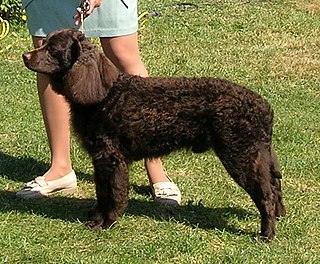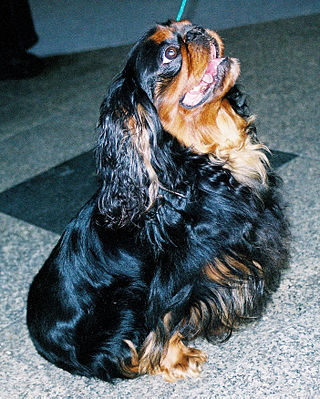
The Shiba Inu is a breed of hunting dog from Japan. A small-to-medium breed, it is the smallest of the six original breed of dogs native to Japan. Its name literally translates to "brushwood dog", as it is used to flush game.

A Bichon Frisé is a small breed of dog of the bichon type.

The Pomeranian is a breed of dog of the Spitz type that is named for the Pomerania region in north-west Poland and north-east Germany in Central Europe. Classed as a toy dog breed because of its small size, the Pomeranian is descended from larger Spitz-type dogs, specifically the German Spitz.

The Chinese Crested Dog is a hairless breed of dog. Like most hairless dog breeds, the Chinese Crested Dog comes in two varieties, without hair and with hair, which can be born in the same litter: the hairless and the powderpuff.

The Bulldog is a British breed of dog of mastiff type. It may also be known as the English Bulldog or British Bulldog. It is a medium-sized, muscular dog of around 40–55 lb (18–25 kg). They have large heads with thick folds of skin around the face and shoulders and a relatively flat face with a protruding lower jaw. The breed has significant health issues as a consequence of breeding for its distinctive appearance, including brachycephaly, hip dysplasia, heat sensitivity, and skin infections. Due to concerns about their quality of life, breeding Bulldogs is illegal in Norway and the Netherlands.

The American Cocker Spaniel is a breed of sporting dog. It is a spaniel type dog that is closely related to the English Cocker Spaniel; the two breeds diverged during the 20th century due to differing breed standards in the US and the UK. In the United States, the breed is usually called a Cocker Spaniel, while elsewhere in the world, it is called an American Cocker Spaniel to distinguish it from its older English cousin. The word cocker is commonly held to stem from their use to hunt woodcock in England, while spaniel is thought to be derived from the breed's origins in Spain.

The American Water Spaniel is a breed of spaniel which originated in the United States. It was developed in the state of Wisconsin during the 19th century from a number of other breeds, including the Irish and English Water Spaniels. The breed was saved by Dr. Fred J. Pfeifer, who set up the breed club and standard, and whose work led to recognition for the breed by the United Kennel Club, and later, the American Kennel Club. While they are the state dog of Wisconsin, they remain a rare breed.

The Papillon, also called the Continental Toy Spaniel, is a breed of dog, of the spaniel type. One of the oldest of the toy spaniels, it derives its name from its characteristic butterfly-like look of the long and fringed hair on the ears. A Papillon with dropped ears is called a Phalene.

The Cavalier King Charles Spaniel (CKCS) is a British breed of toy dog of spaniel type. Four colours are recognised: Blenheim, tricolour (black/white/tan), black and tan, and ruby; the coat is smooth and silky. The lifespan is usually between eight and twelve years.

The French Bulldog, French: Bouledogue Français, is a French breed of companion dog or toy dog. It appeared in Paris in the mid-nineteenth century, apparently the result of cross-breeding of Toy Bulldogs imported from England and local Parisian ratters. It is commonly kept as a pet, and is among the most frequently registered dogs in a number of countries including Australia, the United Kingdom, and the United States. The breed is susceptible to various health issues as a consequence of breeding for their distinctive appearance, especially the brachycephalic face and skin wrinkles.

The Brittany Spaniel, French: Épagneul Breton, is a French breed of gun dog of spaniel type, bred primarily for bird hunting.

A luxating patella, sometimes called a trick knee, is a condition in which the patella, or kneecap, dislocates or moves out of its normal location. It can be associated with damage to the anterior cruciate ligament.

The King Charles Spaniel is a small dog breed of the spaniel type. In 1903, the Kennel Club combined four separate toy spaniel breeds under this single title. The other varieties merged into this breed were the Blenheim, Ruby and Prince Charles Spaniels, each of which contributed one of the four colours available in the breed.

The Dutch Shepherd is a herding dog of Dutch origin. They were used by shepherds and farmers who needed a versatile dog, with few demands, and a dog that was able to adapt to a harsh and meager existence.

The Boykin Spaniel is a medium-sized breed of dog, a Spaniel bred for hunting wild turkeys and ducks in the Wateree River Swamp of South Carolina, in the United States. It is the state dog of South Carolina, where it was discovered and further developed by hunters in the early through mid 1900s. September 1 is Boykin Spaniel Day in South Carolina, originally established in 1984.

The Orthopedic Foundation for Animals (OFA) is a nonprofit organization based in Columbia, Missouri, that aims to research and prevent orthopedic and hereditary diseases in companion animals.
As a private not-for-profit foundation, the OFA has funded nearly $3 million in research aimed at reducing the incidence and prevalence of inherited companion animal disease. The OFA funds projects through the AKC Canine Health Foundation, the Morris Animal Foundation, and occasionally through direct grants. The OFA has achieved Ruby Donor status with MAF, and Millennium Founder status with the AKC CHF. OFA supported research is not limited to orthopedic disease, and has included cancers, heart disease, and thyroid disease as examples. Some research has been breed specific, some for all breeds, some for multiple species, and has been done at many of our leading universities and research institutions. With the recent completion of the mapping of the canine genome, the OFA is focusing more of its research dollars towards research at the molecular level.

The French Spaniel is a breed of dog of the Spaniel-like setter. It was developed in France and Canada as a hunting dog, descended from dogs of the 14th century. Popular with royalty during the Middle Ages, it nearly became extinct by the turn of the 20th century but was saved by the efforts of Father Fournier, a French priest. One of the largest breeds of Spaniel, it typically has a white coat with brown markings. It is a friendly breed that has few health issues, but can be affected by a syndrome called acral mutilation and analgesia. The breed is recognised by Canadian and international kennel clubs but not by The Kennel Club (UK). The American Kennel Club has included the breed in its Foundation Stock Service, the first step to full recognition.

Brachycephalic airway obstructive syndrome (BAOS) is a pathological condition affecting short nosed dogs and cats which can lead to severe respiratory distress. There are four different anatomical abnormalities that contribute to the disease, all of which occur more commonly in brachycephalic breeds: an elongated soft palate, stenotic nares, a hypoplastic trachea, and everted laryngeal saccules. Because all of these components make it more difficult to breathe in situations of exercise, stress, or heat, an animal with these abnormalities may be unable to take deep or fast enough breaths to blow off carbon dioxide. This leads to distress and further increases respiratory rate and heart rate, creating a vicious cycle that can quickly lead to a life-threatening situation.

Raad van Beheer op Kynologisch Gebied in Nederland is the official kennel club of the Netherlands. Founded in 1902, it currently represents around 200 breed clubs with 150,000 members, and is a member of the Fédération Cynologique Internationale (FCI).

The Pumi is a medium-small breed of sheep dog from Hungary. They are capable herding dogs, able to gather and work close to farm stock, particularly sheep, to keep them under control. Pumik have an extended, tapered muzzle with prominent ears, and a tail curled over their back, and are sometimes described as having a whimsical expression. The double coat has a mix of wavy and curly hair.






















